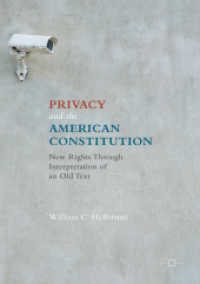- ホーム
- > 洋書
- > 英文書
- > Business / Economics
Full Description
Labor income risk is key to the welfare of most people and this risk is mainly insured 'within the firm' and by public institutions, rather than by financial markets. Risk Sharing within the Firm: A Primer starts by asking why such insurance is provided within the firm, and what determines its boundaries. It identifies four main constraining factors: availability of a public safety net, moral hazard on the employees' side, moral hazard on the firms' side, and workers' wage bargaining power. These factors explain three empirical regularities: family firms provide more employment insurance than nonfamily firms; the former pay lower real wages, and firms provide less employment insurance where public unemployment benefits are more generous. This monograph also explores the connection between risk sharing and firms' capital structure. It concludes by showing that risk sharing within firms has declined steadily in the last three decades, and by discussing the financial, competitive, technological and institutional developments that may have conjured this outcome.
Contents
1. Introduction
2. Why Risk Sharing Within the Firm?
3. What Limits Risk Sharing Within the Firm?
4. Insurance Provision by Family Firms and Government Programs
5. Firm Leverage and Employment Risk
6. Insuring Employees Against Talent Uncertainty
7. Whither Firms' Insurance Provision?
8. Conclusion and Directions for Future Research
Acknowledgements
References








